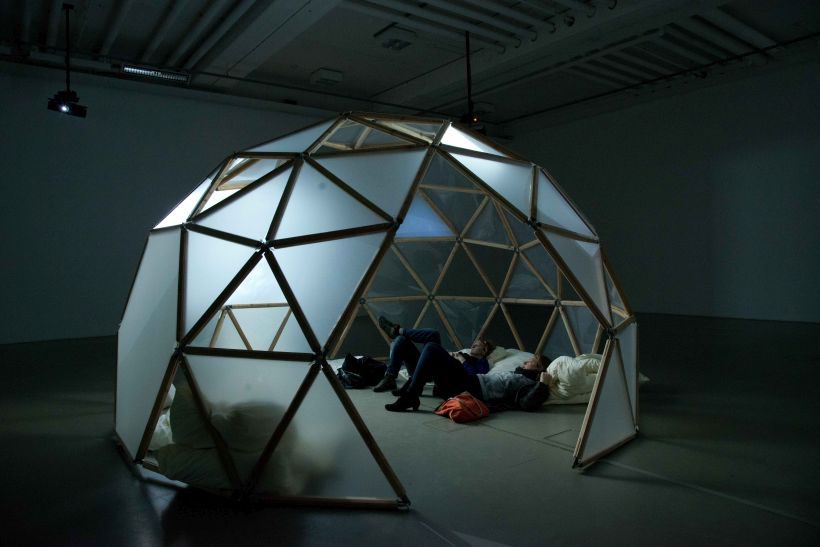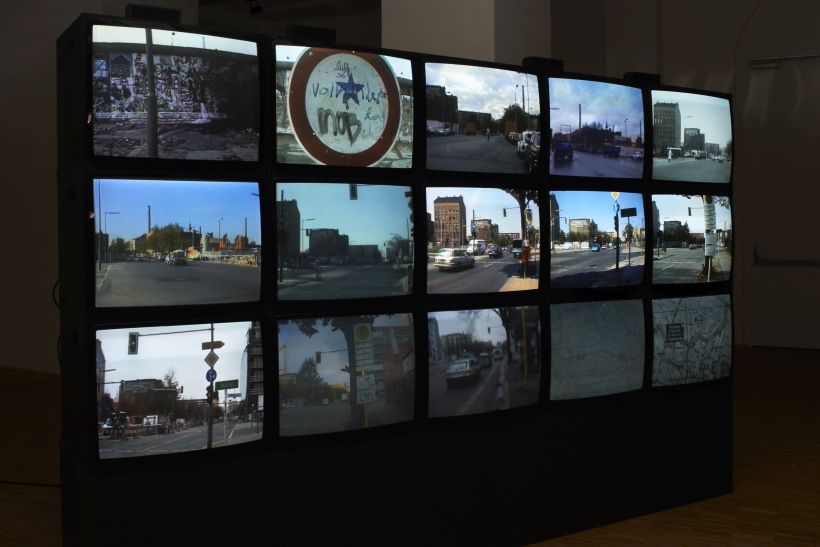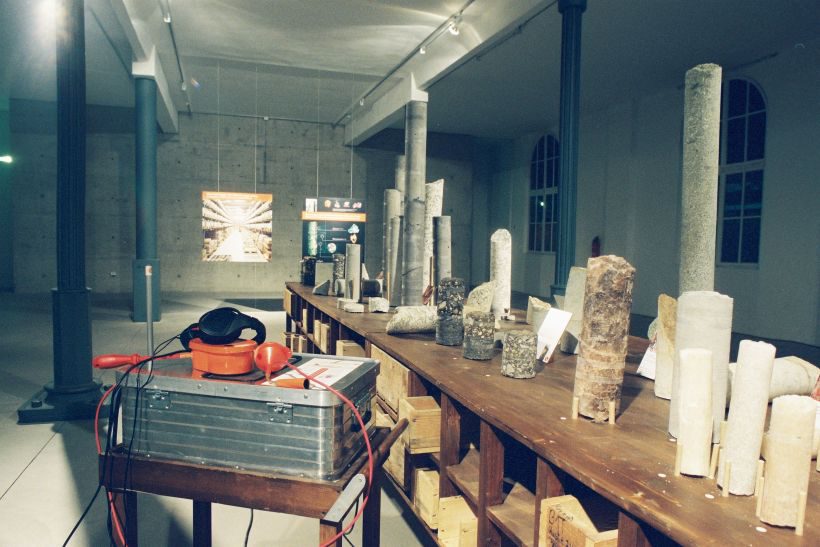Reflections on some criteria for film, space and physicality

Mathilde ter Heijne, „Experimental Archeology; Ontology of the In-Between“, 2014 © Kasseler Dokumentarfilm- und Videofest 2015
Since 1997, an exhibition section entitled “Monitoring”, in which an average of sixteen media installations are shown, has been a component of the annual Kassel Documentary Film and Video Festival. This exhibition with its presentations of individual video installations and sculptures has been developed as a conscious addition to the film programmes since 1989. However, it was first able to establish its profile – the displaying of installative filmic works in a large space – when it moved to its more spacious location in the south wing of the Kulturbahnhof Kassel in 2001.
One central aspect of the event has repeatedly been the question of what constitutes the character of a media installation, as well as the issue of how necessary it is to exhibit the items on display permanently for the complete length of the festival, instead of having them temporarily in the cinema. The Kassel Documentary Film and Video Festival permits a choice between both of these presentation formats. Each year in November during the six-day event, thematically compiled short and feature films are screened in programmes in the festival cinema. Sometimes, the cinema itself is even transformed into the location of an installation, by projecting a loop that refers in some way to the history of film, beyond the normal film screenings times.[1]
For more than sixteen years now, I have been involved in running the exhibition, to which about 300 proposals for installations are submitted each year. A selection from these submissions is undertaken by an expert committee, which bases its decisions on the one hand on quality criteria, and on the other hand on achieving a contextually convincing structure through the interplay and interaction of the pieces chosen. The range of artistic-filmic approaches is vast, and repeatedly triggers off discussions among the members of the selection committee about the relevance of these pieces in relation to the spatial installative presentation. Which provides an opportunity to attempt to summarise the criteria and propose a definition in turn for what it is that constitutes media installations which integrate short films into them to a major extent as well.
Among the proposals for installations submitted each year to Kassel, there are frequently filmic works, which are intended for screening using the largest possible stand-alone projection. Some of these pieces have a narrative arc with a beginning and an end for which their dramatic suspense requires a linear screening process, as their storyline structure would disintegrate were the end of the film to be seen before the start. Which is something that would occur inevitably were such pieces to be projected as a loop in an exhibition. So we usually hand over such works to our colleagues in the selection committee for the film programmes, for screening in the cinema. Unless of course there are substantial grounds for arguing that the film should be screened as a projection in the exhibition space. Such a reason could for instance be a singular spatial and physical presence in the images, which impacts differently when a viewer is able to move with them by standing in front of or walking past them, rather than remaining seated in the cinema. When sitting in a darkened cinema auditorium and relaxing in our softly padded seats, we have become used to subduing our physical self-perception, our sense of the corporal. This however is not the case in an exhibition space. Here, the plurality of the images with their landscapes and architectures, figures and objects are compared in a completely different way with the dimensions of our bodies. And this becomes even more extenuated in the alteration of our distance to the projection through our movements in space and thus we are also able to determine through this our relationship to the motifs in the projection. Differing aspects can be decisive in this regard, such as an abundance of details which we would like to see more closely, a fast movement which can be better viewed from further away, or even a close-up of a face from which we might prefer to gain some distance. Another factor which can argue for projecting a film in an exhibition space is the sound, which may perhaps have a quality that can only be achieved by using special equipment, or which might even in itself be intended as a stand-alone sound installation with several sound tracks that complement the events in the film on an audible level in parallel at several locations.
However, one decisive criterion is the dramatic development in a work, and the question of whether it concerns a film or a loop. Does the piece have a beginning and an end, and perhaps even a film title and credits? Or do the start and end of the film merge with each other smoothly, so that no break is visible in the editing and the camera movement to indicate that the “film” begins again? In loops with monotonous movements, as well as in images of waves swelling on the high seas or of leaves in a forest being rustled by the wind, this edit cut sometimes becomes invisible by screening the film forwards and backwards alternatively. And with such movements, the direction in which the film is running becomes irrelevant. Situations can be built up and unravel again in a comparable way using such loops: With an emptiness on the one hand and an abundance on the other marking the respective transitions, such as for instance in the form of an event that culminates on a square, but which then runs its course again and reveals the empty and abandoned square, before the reappearance of the protagonist. The same invariable motif or the constant repetition of an action represent fundamental principles of the loop.
One unique variety is the self-generating image that continuously reshapes itself – usually with abstract compositions – by means of computer-based parameters. Likewise, an endless variation of differing edited film blocks is possible, which utilise a pool of sequences as its basis[2] and constantly re-edits them anew, as indeed is a comparison of double variants at play from differing perspectives.[3]
However, the spatialisation of a film for the exhibition situation is usually achieved by having multiple projections, in which a splitting up of the perspectives occurs. The simplest form of this is the double projection, which provides a dialogic structure: As two heads in conversation, or as formal and contextual comparisons between places, objects and actions.
To some extent, material – such as footage shot when producing a film – is also used in such exhibitions, but applied in an alternate way. In some cases, already during the planning for a film project, the intention is to make double usage of the footage as a film and as an installation.[4] This is arranged in a strict temporal order in the linear structure of the film becoming separated across several channels in the installation. The directive, authorial narrative style in the predefined edited film sequences, which determine the order in which perspectives occur and comment on each other, is relinquished through their separation in favour of a polyphony of views, in which each observer, by means of their own decisions and movements, wanders through the space from image to image, between the projections and monitors, and thus determines their own sequence and length of time spent at each moment. For these forms of non-linear narration, new and expanded possibilities have emerged thanks to the computer-based feeding in of the single films. In this case, the editing occurs either on the basis of a random principle that repeatedly creates new combinations from the material available, or via a selection menu which permits unrestricted free access, or structures its decisions on the basis of keywords or “tools”.[5]
The spatialisation contained within this is initially virtual in the sense of the “cloud”, but it can be achieved in an exhibition space as well, so that movements from one perspective to another are also possible physically. Moreover, by entering parallel requests to the same material by different exhibition visitors at several “consoles”, the various differing accesses can be compared with each other, making the related interests of the users for a meta-level of comparison transparent and comprehensible.
The polyphony of the images has several faces. Those which occur repeatedly include the “talking heads”: Face and shoulder portraits of various people telling us their viewpoint of an event or a subject.[6] With each of them a short film in which the selection of the material, the editing and the length co-determine if and how long they are capable of capturing our attention, and that especially also when we consider how many other voices belonging to the installation want to be heard, before the desired overall view of a polyphony is able to unfold itself commensurably.
With such a chorus of channels, one form here is also the option to present the same participant in differing roles, with not only human protagonists being meant by this, but also places and objects. Artists present themselves in this way as masters of transformation, as quick-change artists.[7] Wearing different clothes, a person encounters themselves and doing so explores the possibilities for differing identity patterns. Or a place becomes the protagonist, in that footage shot at differing times, or at various times of the day or decades for instance, illustrates the shifts in moods and feelings, or some historic upheavals and events.[8] In this way, contemporary historic spaces are created which claim a presence for themselves to an equal extent, either through the abundance of material or through their re-envisioning in large-scale projections.

Rotraut Pape, „Die Mauer – Der vertikale Horizont“, 1989-2009 © Kasseler Dokumentarfilm- und Videofest 2009
The re-envisioning of spaces not only occurs via the substantial dimensions of the projection areas, but also through the lining-up next to each other of large-scale images, through to the screening of synchronised and interrelated films that fill the complete space in the form of a panorama. In this way, the video installation is showing itself to be in the tradition of large-scale artistic displays from the 19th century, that sought to impress their audiences through the sheer scale of the painted panoramas, into whose artistic spaces of illusion the viewers felt they were able to “really” enter physically and experience the exoticism of the scenes presented there – such as historic battles, faraway lands, mythological sceneries or crusades.
Likewise, in the sense of this real presence, an expansion is also provided to the medium beyond the flat film image when it is connected with three-dimensional factors, such as with architecture or sculptures being utilised as the basis for the projection. This position takes us back to the early days of media installations, to the interplay of flexibly assembled objects, to alternating light situations and reflections, which additionally modulate and break the image.[9] The potential contained in such productions has expanded powerfully thanks to the technical possibilities available today, however the fundamental principle remains: By having images projected onto them, objects acquire new dimensions in a contextual, formal and temporal respect, and these can be completely everyday things which are being examined in terms of their quality as “screens”.[10] To some extent, film images and the “settings” in which they are integrated can also complement each other. The non-moving stage design of the installation and the moving film image coupled to it provide a mutual expansion for each other in differing directions, with the film acquiring a level whereby it is capable of being experienced spatially and physically, while the objects in the space are being commented on in a temporal-narrative way.[11] The relationship between a spatial installation and the related video being screened within it can be very simple, such as when the projected image becomes a window.[12] Or the video is a stand-alone component that is not integrated into the installation, but running next to it, illustrating how the exhibited sculptures are being utilised. In this way, a performance arises in the exhibition space, the temporary staging of an action being captured, recorded and performed permanently in its medial representation. To some extent, such performance videos can certainly seem more like films that should be screened in the cinema as part of a corresponding thematic programme and gain the attention that befits them there. However, it is also true that the encounter between the viewer and the film image signifies a more direct physical – bodily – confrontation within the spatial conditions of an exhibition. And if objects and sculptures which can be seen in the documentary and are used there are also included in the exhibition, then the objects and the film also complement each other here to form a whole.[13] In such interrelations, the films assume the role of a “manual” to some degree, explaining how the objects function and showing the users how they could handle them, or for instance how a fictive user would do so.[14]

Agnes Meyer-Brandis – Borkernlabor und Elfen-Scan 2003 © Kasseler Dokumentarfilm- und Videofest 2004
In this regard, the video projection functions as “animation” in that is simply evokes the illusion of movement or animacy. However, when so utilised, above and beyond this it reveals the fundamental human longing for an encounter with the animated unknown, which is also to be found in those things which are accorded their own life through being projected.[15] And the projecting of such imaginings onto objects has been a summoning ritual since time immemorial[16], as indeed an occasion for psychoanalytical reflection, as well as the basis for the media installation’s technical realisation.
The reflections and criteria being broached here arise from our involvement with the great abundance of differing proposals for media installations which are submitted to the Kassel Documentary Film and Video Festival annually, and from which sixteen are realised and exhibited each year. The potential to occupy the installation space with a narrative form as well, such as the short film, and to utilise the options for having a multi-perspective as described on the one hand and a physical – corporal – effect on the other, represent a central ambition of the Monitoring events. And in this regard, in addition to the range of differing subjects and themes, the vast array of variants in the installations themselves is impressive and always exciting. But still, certain forms and patterns in the medial structures can be identified which, if they were to be described in more detail, could result in something like a kind of “typology of the media installation”. To do so, individual analyses of the works and the respective approach of the artists would also need to be undertaken to a greater degree, in order to recognise and appreciate the complexity of the filmic-artistic pieces and at the same time to describe their contextual consequences for any media utilisation.
[1] For instance, Stan Douglas, “Overture”, 1986 (Monitoring 2001).
The examples selected are not necessarily all items from the Monitoring exhibitions at the Kassel Documentary Film and Video Festival (catalogue at http://www.kasselerdokfest.de/de/festival/monitoring/ archive section), and instead concern reference works which have been chosen arbitrarily to some extent and for which there is certainly also other exemplifications.
[2] For instance, Stan Douglas “Win, Place or Show”, 1998.
[3] For instance, Keren Cytter, “Untitled”, 2009 (Monitoring 2010).
[4] For instance, Chantal Akerman, “De l’autre coté”, 2002 (Documenta X).
[5] For instance, Florian Thalhofer, “Korsakov Syndrom”, 2000 (Monitoring 2001).
[6] For instance, Multiplicity, “Solid Sea”, 2002 (Documenta X).
[7] For instance, Björn Melhus, “The Oral Thing” 2001.
[8] For instance, Rotraut Pape, “Die Mauer – Der vertikale Horizont”, 1989-2009 (Monitoring 2009).
[9] For instance, Laszlo Moholy-Nagy: “Licht-Raum-Modulator”, 1930
[10] For instance, Tilman Aechtner, Yoonsun Kim, Carolin Liebl, Nicolas Schmidt-Pfähler: “Lichtmaschine”, 2014 (Monitoring 2014).
[11] For instance, Christine Schulz, “Alert”, 2006 (Monitoring 2007).
[12] For instance, Any and Sibel Öztürk, “Preparations for a Journey”, 2002 (Monitoring 2004).
[13] For instance, Mathilde ter Heijne, “Mathilde, Mathilde…”, 1999.
[14] For instance, Agnes Meyer-Brandis, “Bohrkernlabor und Elfen-Scan”, 2003 (Monitoring 2004).
[15] For instance, Tony Oursler, “F/X Plotter”, 1992 (Documenta IX).
[16] For instance, Mathilde ter Heijne, “Experimental Archeology; Ontology of the In-Between”, 2014 (Monitoring 2015).